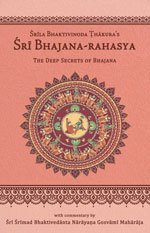Bhajana-Rahasya
by Srila Bhaktivinoda Thakura Mahasaya | 2010 | 123,965 words
The Bhajana-rahasya Text 15, English translation, including commentary (vritti). The Bhajana-rahasya is a compilation of verses describing the mercy of the eight pairs of names (Yugala-nama) of the Maha-mantra. This is text 15 belonging to the chapter “Dvitiya-yama-sadhana (Pratah-kaliya-bhajana)” representing the first six dandas of the morning: approximately 6.00 a.m.–8.30 a.m.
Text 15
The fourth verse of the catuḥ-ślokī of Śrīmad-Bhāgavatam (2.9.36) states:
एतावद् एव जिज्ञास्यं तत्त्व-जिज्ञासुनात्मनः
अन्वय-व्यतिरेकाभ्यां यत् स्यात् सर्वत्र सर्वदाetāvad eva jijñāsyaṃ tattva-jijñāsunātmanaḥ
anvaya-vyatirekābhyāṃ yat syāt sarvatra sarvadāOne who is inquisitive to know the true nature of the self (ātmatattva) inquires through direct (anvaya) and indirect (vyatireka) means of deliberation about that object, which is fully eternal.
अनर्थ-नाशेर यत्न दुइ त’ प्रकार
अन्वय-मुखेते व्यतिरेक-मुखे आरanartha-nāśera yatna dui ta’ prakāra
anvaya-mukhete vyatireka-mukhe āraअन्वय-मुखेते विधि भजन-विषये
व्यतिरेक-मुखेते निषेध नानाश्रयेanvaya-mukhete vidhi bhajana-viṣaye
vyatireka-mukhete niṣedha nānāśraye
Commentary: Bhajana-rahasya-vṛtti:
After Brahmā took birth, he asked Śrī Bhagavān four questions, which the Supreme Lord answered through the catuḥ-ślokī. These four verses are famous as Catuḥ-ślokī Bhāgavata because they are the seed of Śrīmad-Bhāgavatam. They contain the very essence of the Vedas, Vedānta and all other Vedic scriptures.
Philosophical knowledge of Śrī Bhagavān, His eternal form, His qualities, pastimes, etc., are all described in the first of these verses in the form of aphorisms (sūtras). In the second verse, māyā-tattva, which is separate from Bhagavān’s eternal form, is discussed, as is the material world (jaḍa-jagat ). The sambhanda-jñāna found in these two verses should be understood. The third verse describes the existence of Śrī Bhagavān’s eternal svarūpa, separate from His relationship of inconceivable difference and non-difference (acintya-bhedābheda) with the living entities and matter. It also describes how the living entities, by taking shelter of the Supreme Lord’s lotus feet, attain the treasure of the most elevated prema.
This Text 15 is the fourth verse of Catuḥ-ślokī Bhāgavata, and it describes sādhana-bhakti, the means for obtaining the abovementioned supreme goal. Direct following, or anvaya, means to accept the rules of sādhana-bhakti with a favourable mood. The word vyatireka is used in regard to avoiding those actions that are unfavourable and that cause obstacles in obtaining the desired goal. The path of sādhana is known as abhidheya (the process). In other words, that instruction which is obtained from the scriptures through direct interpretation (abhidhā-vṛtti) is known as abhidheya. This is described in this Text. Sādhana-bhakti, which is none other than abhidheya, is not dependent on time, place, performer or circumstance. The duty of all living entities is to perform sādhana-bhakti in all places, at all times and under all circumstances. The sādhaka should inquire and hear from the spiritual master about sādhana-bhakti.
In this Text, the confidential meaning of ‘direct’ and ‘indirect’ indicates the union (saṃyoga) and separation (vipralambha) found in Vrajendra-nandana Śyāmasundara’s amorous pastimes (śṛṅgāra-rasa) with His most beloved vraja-sundarīs. To deceive the conditioned living entities, all these priceless jewels are kept well protected in a box that the jñānīs and aiśvarya-bhaktas are unable to open. That guru who is adept at relishing the rasa of Vraja displays its contents only to his qualified disciples.
